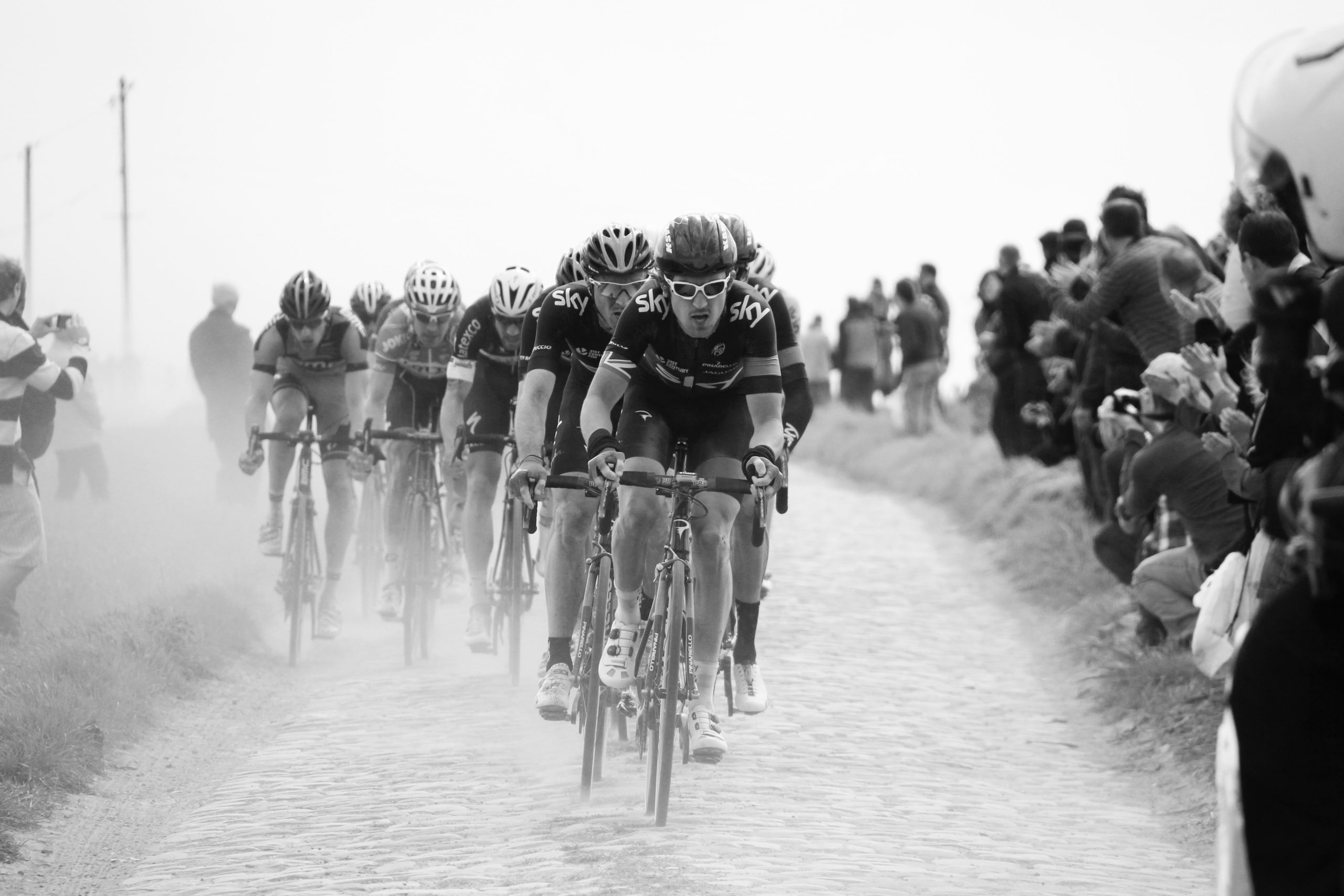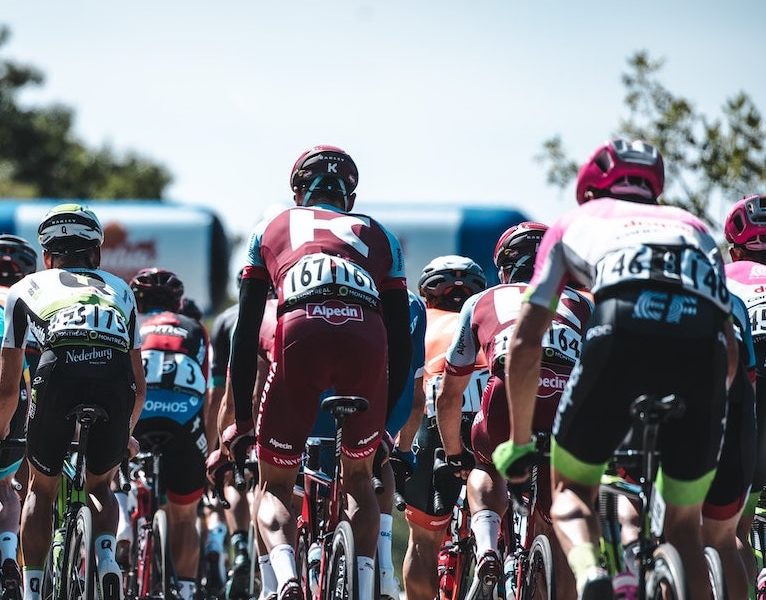August 18, 2020
With the arrival of August, fans of cycling felt a sense of normality in what has been anything but a normal year because of the coronavirus. What we witnessed at the end of Stage 1 of the Tour of Poland highlights one of the main reasons for forming the Pro Cyclist Foundation, and why sufficient funding and independence from the governing cycling bodies is so important. We aim to provide male and female professional cyclists with legal, wellness and career support. The issue of why we are focused on wellness, and its subset of rider safety, was again unfortunately demonstrated at the WorldTour level.
Groenewegen
A video replay of the finish makes it clear: Groenewegen deviated from his line significantly. He also “closed the door” by sticking out his right elbow, further supporting the case that he was intentionally blocking Fabio Jakobsen. Groenewegen’s line deviation caused the crash.. Obviously this is not the first time a sprinter failed to hold a straight line toward the finish, or closing the door on a rider about to overtake them. In this case, however, Groenewegen caused a horrific crash as Jakobsen fell into the barriers, which separated, leading to the crash consuming a mass of the field.. Had Jakobsen not fallen, but instead simply let up, Groenewegen might still have been disqualified, as Sagan was in the Tour de France in 2018. In this case, the injuries sustained by Jakobsen and the rest of the field increase the severity of the potential sanctions against Groenewegen.
We certainly do not believe that it is acceptable for Groenewegen to have caused a horrible crash. We were surprised, however, that the UCI’s statement focused on blaming the rider, and failed to mention an issue with the finish line structure and the downhill format finish of the race, which certainly led to catastrophe.
The Finish Line Structure
Groenewegen’s actions obviously deserve some examination, but we also believe that attention should be given to the finish line structure. The structure of the barriers, the finish line gantry, and the downhill finish ensured that if there was a crash, it would be a devastating one, likely resulting in serious injuries. Riders were traveling in excess of 50 miles per hour heading towards the finish line, and the profile of stage one was nothing short of promising a sprint finish.. At that speed, any crash near the line guaranteed serious injuries At minimum one can expect road rash, or with more consequence, broken bones.
The barriers at the finish offered no protection to Jakobsen. Instead of the barriers protecting Jakobsen from hazards on the side of the course, which could be equipment, cars, or even spectators, he went through them. Barriers should deflect riders back into the road, but instead, these barriers separated and flew into the field, causing even more crashes.The barriers should be a safety feature of the finish line for the riders, not a hazard. Additionally, not only did Jakobsen crash straight through the barriers, which then splintered into projectiles into the field, but then he went head first into the finish line structure.
In other professional sports, there are standardized safety features mandated to protect the athletes. For example, in the NBA, there are specific regulations about the space around the basket, as well as the number of people on the baseline, such as photographers. The NFL requires field certifications to protect players, with experts testing various components of the field to ensure the safety of the players. Cycling needs to focus on protecting its professional athletes from potential life threatening hazards. Eliminating dangerous finish line conditions should be an obvious focus.
The UCI’s Response
In its statement in the immediate aftermath of the crash the UCI said it “strongly condemns the dangerous behaviour of rider Dylan Groenewegen, who sent Fabio Jakobsen into the barriers a few metres from the finish, causing a collective crash at the end of the first stage of the Tour of Poland”.
Additionally, the UCI stated that it had sent to the “disciplinary commission to request the imposition of sanctions commensurate with the seriousness of the facts”. No mention was made of how the finish line set-up failed or that it would be reviewed. The approach of the UCI is to punish a rider whose sprinting caused the beginning of a devastating chain of events. The UCI, however, failed to examine the various other contributing factors, and more importantly, the structure of the finish line, so that rider safety would be improved going forward.
What Should Happen?
Riders must be held accountable for their actions, but event organizers and governing bodies must equally accept the responsibility of preventing an accident from resulting in disaster. Rider sanctions aside, the appropriate response for this event would be to first, standardize finish line structures for all events as mandated and inspected by experts in rider safety. Second, extend efforts made to maximize safety at the finish to cover the entire course, especially at the WorldTour level. Finally, downhill sprint finishes should be banned, altogether: flat sprint finishes are easily sufficient for specialized athletes to exercise their sprinting talents without the accompanied risk of 50mph+ speeds which only increase risk exposure.
Why Is No Action Being Taken?
The rider advocacy group, known as the CPA, is seen as the entity to represent professional cyclists’ best interests and as the advocate for safe racing conditions. In other industries and sports, a union or advocacy group such as the CPA would take action to raise the safety concerns with the governing regulatory body, such as the UCI in this case. Unfortunately, the UCI and race organizers are the largest financial supporters of the CPA. This conflict of interest interferes with the independence of the CPA. The changes required to ensure a safe finish would require additional expenses for race organizers, as well as the UCI who would need to enforce new rules and regulations. The CPA is muzzled in its ability to independently lobby for changes given its funding structure.
How Pro Cyclist Foundation Could Get Involved
Pro Cyclist Foundation operates with a mission to offer legal, wellness and career support for male and female pro cyclists. Stepping in as an independent entity to advocate and lobby for rider safety is a clear and needed solution. The CPA has its hands tied with funding from the UCI and race organizers. Cyclists need representation separate from the UCI, a regulator and commercial operator in the sport.
The Pro Cyclist Foundation operates independently with one separate and independent goal. The Foundation does not operate a team, profit from race operations, or operate on a budget from a regulatory entity. The Foundation’s sole mission is to benefit the professionals in the sport, and with a budget ultimately sourced by fans of the sport. Our Foundation garners support from cyclists and cycling enthusiasts to make professional cycling a safe and sustainable profession for the world’s best talents. As the Foundation begins to gain traction and funding, we can help become the voice of the pro peloton that currently lacks an independent and powerful advocate.
The Pro Cyclist Foundation
Denver, Colorado



A Commentary on Concussion in Cycling Part 2